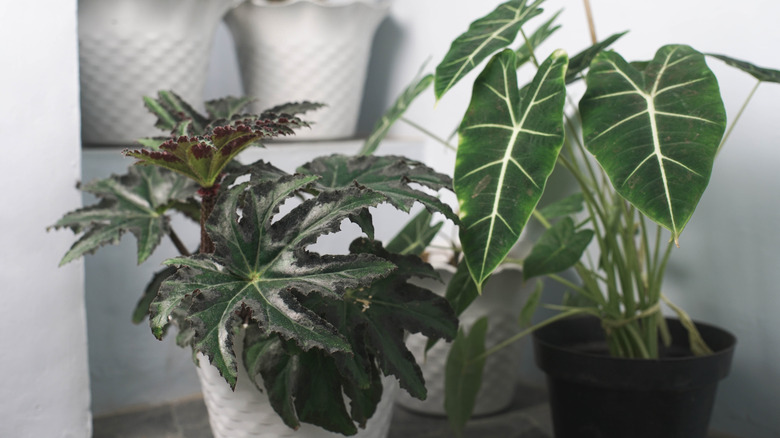How To Winterize Patio Plants So They Last All Year
You have probably adored the sight of your favorite begonias and hostas decorating your patio all summer and right through to fall. After all, there are many simple ways to transform your patio with flowers and plants. But once the temperatures start cooling and the light begins fading earlier each evening, your plants will need some extra love to survive the cold. If you take the right steps, you can protect your prized plants throughout the winter. This is especially the case if you have the right plants for the job — that is, winter-hardy perennials that are not overly sensitive to the temperature fluctuations in your region. All you need to do is place your patio plants in the right pots, add mulch to conserve heat, and slow down on your fertilizers — and you can rest assured that your patio plants will last through the winter.
Since the plants on your patio are growing in pots or containers, the process of overwintering them is different from their garden buddies growing in the soil. In fact, even for the same plant species, spending the winters in pots can be tougher since their roots lack the insulation provided by the garden soil. Containers are also vulnerable to the rise and drop in temperatures during winter, which can cause them to freeze and thaw repeatedly, and, thereby, stress the plant. Before you take steps to protect your plants from the cold, you must ensure that their pots are suitable for surviving the winters. Clay or ceramic pots run the risk of cracking in the cold weather. If that's the type of pots you have, you should repot your plants in fiberglass, metal, resin, or heavy plastic pots.
Tips to protect your patio plants from the winter
Mulching outdoors plants in fall is extremely essential for conserving moisture and heat, and there is no reason why you shouldn't treat your potted patio beauties the same once temperatures begin to drop. Adding a layer of straw, bark, leaves, or hay after the first frost can provide your plants with the much-needed layer of insulation. Letting the plants experience the colder temps helps them go dormant, which protects them from winter weather. Mulching too early could keep them growing.
Furthermore, you can wrap your pots with bubble wrap to give them an extra layer of protection before adding the mulch. Although it might be tempting to take your patio plants near the sun to fight the cold, doing so can actually backfire. Placing your plants directly in the sun can often accentuate the freeze-thaw cycle. Instead, you should consider grouping your pots together and placing them in shade near a wall. This will save your plants from cold winds and provide a more consistent temperature for them.
Apart from taking these direct measures to protect your patio plants, you should also stop any fertilizing well before winters arrive. Since any new growth falls gravely in danger of being damaged by the frost, stop feeding your plants about six weeks before the first killing frost date in your region. Moreover, plants naturally begin to conserve energy and hit dormancy once the temperatures start dropping after fall. If you continue to give your plants an extra dose of nutrients they do not need, it can force them to grow new foliage and not allow them enough time to acclimate to the cold. Excess nutrients can also build in the soil and damage roots.
When to move your patio plants indoors
You can also consider bringing your plants indoors for overwintering, especially if the plant you're growing is a tropical evergreen, like begonia. However, you need to make sure that the plant still receives optimum light and humidity indoors. If dryness is a major issue, install a humidifier to maintain humidity levels indoors.
While checking the hardiness of your plant for surviving the cold in your zone, you should keep in mind that potted plants need extra protection. A good way to measure cold-hardiness for such a plant is going two USDA Zones higher than the zone you're living in. For instance, if you're growing a plant that is hardy in Zone 3, you can only be certain that it will survive in Zone 5 once potted.
Having said all that, a majority of the perennials on your patio actually need a chill period to enter dormancy and come back strong next spring. If you're thinking of moving one of these plants indoors, say in a shed, you should only do so once the temperature has fallen below freezing. Furthermore, you should never completely skip on watering your plants during this time, since the dry nature of potting soil can affect roots. Check the moisture in the soil every few weeks or so with your fingers, and whenever you feel the soil drying out, give your plant a drink.


